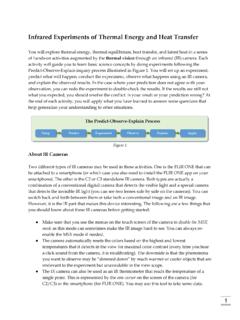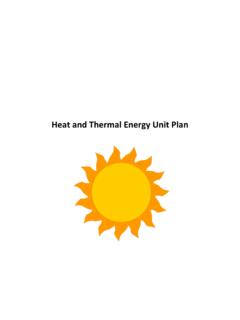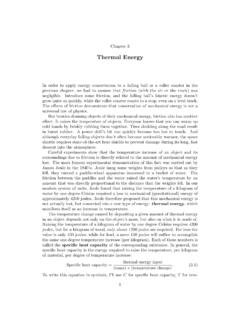Transcription of Chapter 6: Thermal Energy - Ponca Elementary School
1 6 Chapter 6: Thermal Energy Unit 1: Energy and Motion Table of Contents 6 : Using heat : Temperature and heat : Transferring Thermal Energy Temperature You use the words hot and cold to describe temperature. Something is hot when its temperature is high. When you heat water on a stove, its temperature increases. Temperature and heat How are temperature and heat related? Matter in Motion The matter around you is made of tiny particles atoms and molecules. In all materials these particles are in constant, random motion; moving in all directions at different speeds. Temperature and heat Matter in Motion The faster they move, the more kinetic Energy they have.
2 This figure shows that particles move faster in hot objects than in cooler objects. Temperature and heat Temperature The temperature of an object is a measure of the average kinetic Energy of the particles in the object. As the temperature of an object increases, the average speed of the particles in random motion increases. Temperature and heat Temperature In SI units, temperature is measured in kelvins (K). A more commonly used temperature scale is the Celsius scale. Temperature and heat One kelvin is the same as one degree Celsius. Thermal Energy If you let cold butter sit at room temperature for a while, it warms and becomes softer.
3 Temperature and heat Because the air in the room is at a higher temperature than the butter, particles in air have more kinetic Energy than butter particles. Thermal Energy Collisions between particles in butter and particles in air transfer Energy from the faster-moving particles in air to the slower-moving butter particles. Temperature and heat The butter particles then move faster and the temperature of the butter increases. Thermal Energy The sum of the kinetic and potential Energy of all the particles in an object is the Thermal Energy of the object. Temperature and heat Thermal Energy Temperature and heat Because the kinetic Energy of the butter particles increased as it warmed, the Thermal Energy of the butter increased.
4 Thermal Energy and Temperature When the temperature of an object increase, the average kinetic Energy of the particles in the object increases. Temperature and heat Because Thermal Energy is the total kinetic and potential Energy of all the particles in an object, the Thermal Energy of the object increases when the average kinetic Energy of its particles increases. Thermal Energy and Mass Suppose you have a glass and a beaker of water that are at the same temperature. Temperature and heat The beaker contains twice as much water as the glass. The water in both containers is at the same temperature, so the average kinetic Energy of the water molecules is the same in both containers.
5 Thermal Energy and Mass There are twice as many water molecules in the beaker as there are in the glass. So the total kinetic Energy of all the molecules is twice as large for the water in the beaker. Temperature and heat Thermal Energy and Mass Temperature and heat As a result, the water in the beaker has twice as much Thermal Energy as the water in the glass does. If the temperature doesn t change, the Thermal Energy in an object increases if the mass of the object increases. heat heat is Thermal Energy that flows from something at a higher temperature to something at a lower temperature.
6 Temperature and heat heat is a form of Energy , so it is measured in joules the same units that Energy is measured in. heat always flows from warmer to cooler materials. Specific heat As a substance absorbs heat , its temperature change depends on the nature of the substance, as well as the amount of heat that is added. Temperature and heat The amount of heat that is needed to raise the temperature of 1 kg of some material by 1 C is called the specific heat of the material. Specific heat is measured in joules per kilogram Kelvin [J/(kg C)]. Water as a Coolant Compared with the other common materials in the table, water has the highest specific heat .
7 Temperature and heat The specific heat of water is high because water molecules form strong bonds with each other. Water as a Coolant When heat is added, some of the added heat has to break some of these bonds before the molecules can start moving faster. Temperature and heat Water as a Coolant Because water can absorb heat without a large change in temperature, it is useful as a coolant. Temperature and heat A coolant is a substance that is used to absorb heat . Compared to other materials, the temperature of water will increase less. Water as a Coolant In metals, electrons can move freely.
8 When heat is added, no strong bonds have to be broken before the electrons can start moving faster. Temperature and heat Changes in Thermal Energy The Thermal Energy of an object changes when heat flows into or out of the object. Temperature and heat If Q is the change in Thermal Energy and C is specific heat , the change in Thermal Energy can be calculated from the following equation: Measuring Specific heat The specific heat of a material can be measured using a device called a calorimeter. Temperature and heat In a calorimeter, a heated sample transfers heat to a known mass of water.
9 Measuring Specific heat Temperature and heat The Energy absorbed by the water can be calculated by measuring the water s temperature change. Then the Thermal Energy released by the sample equals the Thermal Energy absorbed by the water. Section Check Question 1 How is temperature related to kinetic Energy ? Section Check Answer Temperature is a measure of the average kinetic Energy of the particles in an object or material. As the temperature increases, the average speed of the particles increases. Section Check Question 2 How is temperature related to kinetic Energy ? Answer Thermal Energy is the sum of the kinetic and potential Energy of all the particles in an object.
10 Section Check Question 3 The amount of heat that is needed to raise the temperature of 1 kg of a material by 1 C is called the _____ of the material. A. density B. mass C. specific heat D. Thermal Energy Section Check Answer The answer is C. Specific heat is measured in joules/kilogram C Conduction Thermal Energy is transferred from place to place by conduction, convection, and radiation. Conduction is the transfer of Thermal Energy by collisions between particles in matter. Conduction occurs because particles in matter are in constant motion. Transferring Thermal Energy Collisions Transfer Thermal Energy Thermal Energy is transferred when one end of a metal spoon is heated by a Bunsen burner.









